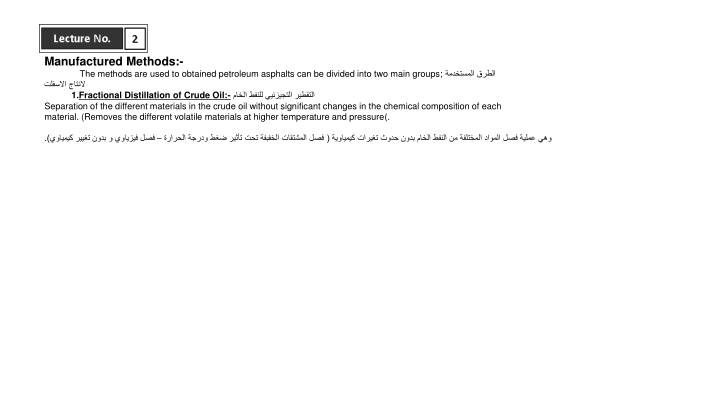
Manufactured Methods for Obtaining Petroleum Asphalts
Learn about the two main groups of methods used to obtain petroleum asphalts: fractional distillation of crude oil and various techniques to produce liquid asphalt including slow-curing, medium-curing, and rapid-curing asphalt, as well as asphalt emulsions classified as anionic and cationic types. Explore different processes involved in the production of asphalt materials.
Download Presentation

Please find below an Image/Link to download the presentation.
The content on the website is provided AS IS for your information and personal use only. It may not be sold, licensed, or shared on other websites without obtaining consent from the author. If you encounter any issues during the download, it is possible that the publisher has removed the file from their server.
You are allowed to download the files provided on this website for personal or commercial use, subject to the condition that they are used lawfully. All files are the property of their respective owners.
The content on the website is provided AS IS for your information and personal use only. It may not be sold, licensed, or shared on other websites without obtaining consent from the author.
E N D
Presentation Transcript
Manufactured Methods:- The methods are used to obtained petroleum asphalts can be divided into two main groups; 1.Fractional Distillation of Crude Oil:- Separation of the different materials in the crude oil without significant changes in the chemical composition of each material. (Removes the different volatile materials at higher temperature and pressure(. .) (
1) Liquid Asphalt ) ( a) Solved by cut back asphalt:- 1) Slow-Curing Asphalts (prime coat); Sc, Can be obtained directly as slow-curing straight run asphalts through the distillation of crude oil by cutting back asphalt cement with a heavy distillate such as oil ( lower viscosity than asphalt and very slow to harden). Sc +( number), this number represent to approximate kinematics viscosity (70, 250, 800 and 3000) centistokes at 60 co. ) . ( 1) Produced by fluxing or cutting the residual asphalt (120-150 penetration) with light fuel oil or kerosene (harden faster than Sc and similar in consistencies). The fluidity of Mc depends on the amount of solvent in material. Mc-3000 (20% solvent) and Mc-70 (45% solvent). Mc, can used for the construction of pavement bases and surfaces. Medium-Curing Asphalt (tack coat); Mc, ) . ( 1) Produced by blending asphalt cement with an oil distillate that will easily evaporate, thereby facilitating a quick change from the liquid form at time of application to the consistency of original asphalt. Gasoline or naphtha is used as the solvent. Rapid-Curing Asphalt; Rc, ) . ( Blown (Oxidized)Asphalts; Is obtained by blowing air through the semisolid residue obtained during the latter stages of the distillation process. Blown asphalt is not used as paving material but it is used as a roofing material, joint filler for rigid pavement. ( .
b) Solved by Water (Asphalt Emulsion) ; Produced by breaking asphalt cement (100-250 penetration range), into minute particles (electrical charges) and dispersing them in water with an emulsifier. " ) ( Asphalt emulsions are classified as:- 1) Anionic: (-) surface active agent (sodium palm slate CH3(CH2)14CooNa) - - + OH- + - + Na H CH3(CH2)14COO - Na(OH)2 Rapid Setting= RS (RS-1, RS-2) 1.Medium Setting = MS (MS-2,S-2h, HFMS-2) 2.Slow Setting = SS ( SS-1, SS-2) h= hardness Anionic emulsifiers are based on fatty acids, these are reacted with a base such as caustic potash or caustic soda (KOH or NaOH ) to form a salt. It is this salt that is the active emulsifier. Figure 4 shows a schematic of such a molecule. The non-polar tail is hydrophobic and hence aligns itself inward to the Asphalt. The polar end is hydrophilic and hence provides the solubility in water. The emulsifier thus attaches itself to the Asphalt particle. The number and density of emulsifier molecules that do this will impart a charge to the surface of the Asphalt particle. This charge will be exactly balanced by the free charges in the water phase. This will be the sodium or potassium ion of the sa
2) Cationic: (+)surface active agent (Lauryl Trimeluy Ammonium chloride C15H31 NH3 CL) a.Rapid Setting= RS (RS-1, RS-2) b.Medium Setting = MS (MS-2,MS-2h, HFMS-2) + + - + C15H31NH3 - +- CL H OH HCL +






















